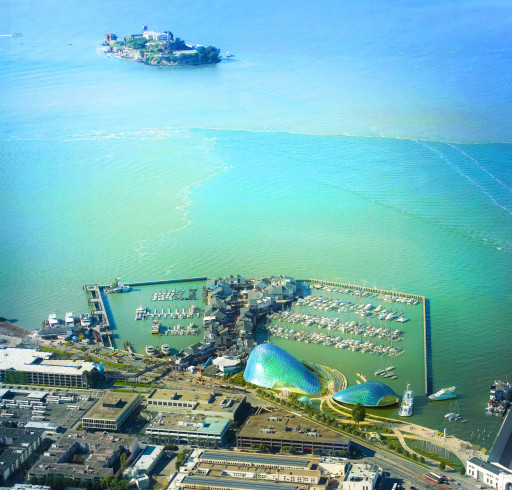
DUBAI, Arab Emirates, October 24, 2023 (Newswire.com) - As the historic UN COP28 Climate Summit draws nearer, the world is facing increasing turmoil and strife driven by geopolitics and avarice for resources. Industrialization, warfare, pillage and depletion of natural resources of land and sea are polluting the air with excessive carbon emissions triggering an ever-increasing chain reaction of climate crises that threatens humanity.
The Climate Concert at Dubai Opera is being hosted by Bay Ecotarium as it celebrates its 42-year legacy in ocean conservation and green advocacy. “Its future transformation into the world’s first Climate and Ocean Conservation Living Museum will leverage Native American environmental stewardship, Silicon Valley technologies including AI, EAI, cloud networking, mobile AR/ VR overlays, immersive experiences, projected holograms, and deep learning, in its bio-mimetic iridescent, organic design inspired by ocean geometry, fish-scales, rippling waves and Ohlone shell-mounds,” says Dr. George Jacob, visionary President and CEO.
Unlike conventional science museum exhibits that often tend to deliver an overdose of data, graphs and technical analysis, the Ecotarium is an evocative platform that is programmed for a three-part trigger. First, to appreciate the wondrous beauty of our Blue Marble we call home in all its magical biodiversity and delicate and complex balance of the web of life. Second, to feel the anguish of a planet in pain that remained silent to the Anthropocene and then began exploding with ominous fury that is existential for human-kind. Third, to remember that our collective future relies on taking decisive action — be it with programs, policy or personal lifestyle choices driven by sustainability and 360 circular economies. At the heart of the Ecotarium is a two-million-gallon saltwater aquarium with 300 species and 30,000 animals that offers a lens to life — silent and unseen — below the depths of the ocean.
Indigenous environmental stewardship in mitigating climate change is integral to conservation efforts — locally and globally. With the office of the President of the USA naming representative Deb Haaland of New Mexico as the Interior Secretary, creating history while honoring heritage, a new era for the environment awaits. Native American Laguna Pueblo lineage makes her the first Native American to ever hold a Cabinet Secretary-level position. A co-sponsor of the Green New Deal, Secretary Haaland brings a unique indigenous perspective to environmental leadership to 574 federally recognized tribes holding sovereign treaties with the United States.
Many indigenous leaders are expected to participate at the UNCOP28 in Dubai Expo City. Two years ago at the UNFCCC Glasgow meet, 137 countries signed Declaration of Forest and Land Use — a $130 trillion commitment to climate finance, and a $1.7 billion pledge of direct support to Indigenous Peoples and local communities. For the first time in the history of the UNFCCC, 28 indigenous peoples were nominated from each of the seven UN indigenous socio-cultural regions to engage directly as knowledge holders and share experiences as indigenous experts with governments
Indigenous Peoples of the world comprise five percent of the world’s population and live on 22 percent of the land that is home to over 75 percent of the global biodiversity. According to the 2018 IPCC Report (Inter-government Panel on Climate Change), the native symbiosis with environment is synonymous with climate solutions. The Special UN IPCC Report on climate change, desertification, land degradation, sustainable land management, food security, and greenhouse gas fluxes in terrestrial ecosystems, draws on indigenous perspectives and practices. Everything from the rotation of crops, plant palette of native species, conservation and forest management practices, water distribution, hunting and fishing levels of consumption, recycling, burning cycles, terrain and geographical nuances, seasonal adaptations, curation of flora and fauna, recognizing vectors of pollination and cross-pollination, and movement of livestock will be at play in regulated measures seeking 360-degree circular economies both at the micro and macro levels. From treaty obligations to Earth Justice, the list of complex issues is long and multi-generational, braided with emotional and trust issues of marginalization, racism, and the specter of "climate refugees" from the tiny pacific island of Kiribati to the mighty burning greens of the Amazon. With over 18,500 indigenous peoples, tribal traditions in the San Francisco Bay Area and languages have survived through sheer tenacity of elders and youth.
Being in the mecca of tech, IT and AI will play a major role in the guest experiences of the Bay Ecotarium. Augmented and virtual reality will immerse visitors into scenarios of real climate change crisis examples and provide an elevated sense of urgency for immediate action. Machine learning, emotional intelligence, Google-driven visual mapping and real-time user engagement will be utilized to further these experiences and create inspiring messaging that translates into real action. The VR platform component of the building can transcend geo-political boundaries and engage upwards of two billion people, despite the physical footprint projections of two million visitors per year.
Contact Information:Vicki de Witt
BayEcotarium Media Relations
[email protected]
(415) 262-4727
Original Source: BayEcotarium Hosts COP 28 Climate Concert at Dubai Opera